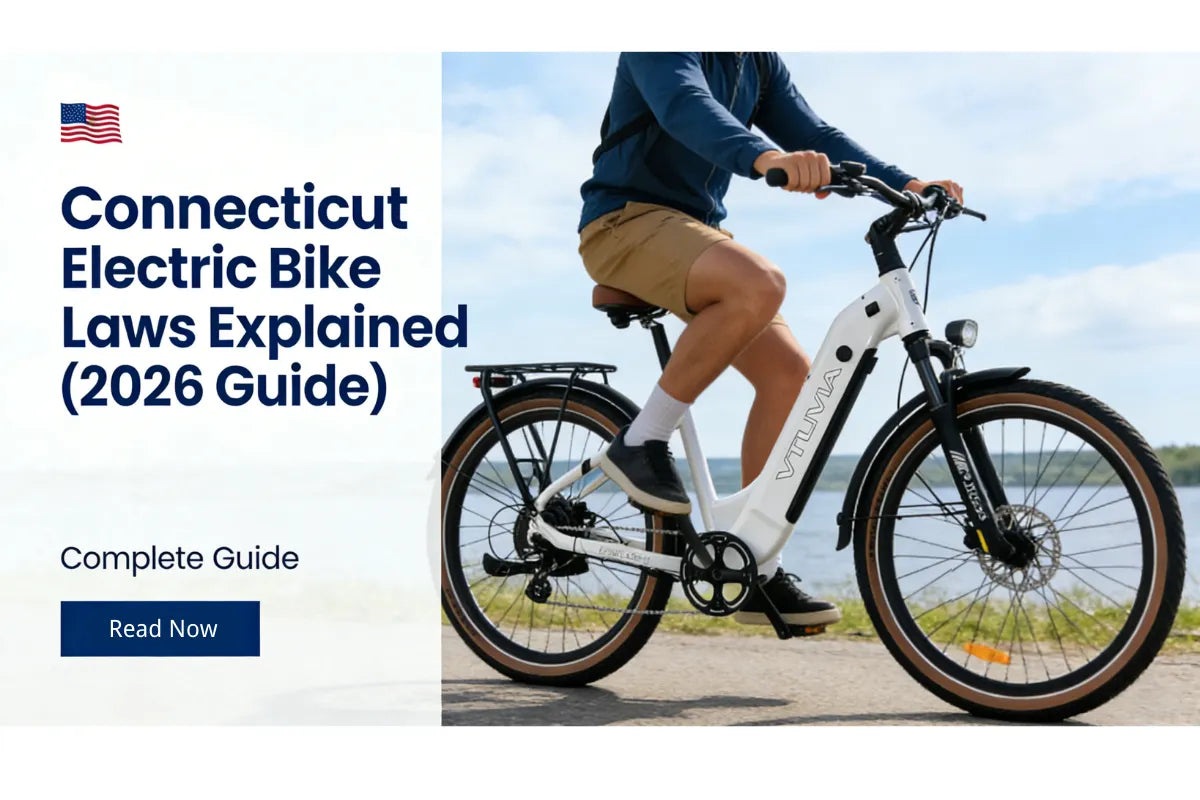While VTUVIA doesn't directly sell e-bike insurance, understanding how to protect your e-bike is essential. Below is a comprehensive guide to e-bike insurance in the U.S.—covering costs, coverage, providers, and tips for choosing the right policy.
Why Consider E-Bike Insurance?
- E-bikes are valuable: high-quality models can cost thousands of dollars.
- Standard homeowners or renters insurance may not fully cover e-bikes, especially for liability or damage.
- Covers risks like theft, collision, third-party liability, and medical costs.
- Provides peace of mind, particularly if you rely on your e-bike daily.
What Does E-Bike Insurance Cover?
- Theft Protection: Loss due to theft, whether at home or elsewhere, depending on the policy.
- Damage Coverage: Accidents, crashes, vandalism, fire, or transport damage.
- Liability: Protection if you injure someone or damage property.
- Medical Payments: Covers medical costs if you are injured.
- Roadside Assistance: Some policies provide emergency support, e.g., up to 35 miles of service.
- Accessory & Parts Coverage: Batteries, spare parts, or riding apparel may be covered.
- Transit Protection: Covers your bike while traveling or moving.
How Much Does E-Bike Insurance Cost in the U.S.?
The cost depends on bike value, coverage type, location, and security measures.
| Coverage Type | Estimated Annual Cost | Notes / Typical Providers |
|---|---|---|
| Liability Only | $100 – $200 | Some state-specific or HOA-required policies |
| Comprehensive (Theft + Damage + Liability) | $150 – $400 | Classic e-bike policies covering multiple risks |
| High-Value E-Bike (>$5,000) | ~5–10% of bike’s value annually (or quoted rate) | Premium bikes; pricing varies by insurer and coverage |
Major U.S. E-Bike Insurance Providers
| Provider | Coverage Highlights | Typical Pricing / Key Features |
|---|---|---|
| Markel | Theft, damage, liability, roadside assistance, transit, spare parts | Policies start around $100/year; optional liability, medical, and 35-mile roadside service |
| BikeInsure | Comprehensive plan including accessories and transit coverage | $16.99/month for base plan; optional theft insurance for $8/month; deductible $100 |
| Other Specialized Policies | Liability-only or “all-risk” e-bike coverage | Based on value, location, and security measures |
Factors That Influence Your Premium
- Value of the e-bike
- Coverage level (basic theft vs. full coverage with liability/medical)
- Location and theft risk
- Security measures: locks, GPS, storage
- Rider’s risk profile: claims history, riding habits
- Deductible: higher deductible lowers premium but increases out-of-pocket costs
- Policy customization: extras such as roadside assistance or transit protection
Is Homeowner or Renter Insurance Enough?
Not always. Standard policies may have limitations:
- Low personal property limits → may not cover high-value e-bikes fully
- Liability or crash damage may be excluded for motor-assisted bikes
- Some insurers exclude e-bikes exceeding certain motor or speed limits
How to Choose the Right Policy
- Assess bike value, including accessories and battery
- Decide which coverages matter most
- Get quotes from multiple insurers
- Check deductible options
- Use security measures to reduce risk and premium
- Keep documentation for claims: receipts, serial numbers, photos
Common Misconceptions About E-Bike Insurance
- "My renter’s insurance covers my e-bike" — Coverage may be limited or exclude liability/crash damage
- "Insurance is too expensive" — Many plans start around $100/year
- "I don’t need liability coverage" — Even recreational use can result in injuries or property damage
- "High-speed or powerful bikes aren’t insurable" — Many insurers cover e-bikes up to specific motor and speed limits
Real-World Examples
- Markel quote for a $3,000 e-bike: ~$499/year with certain coverages
- Velosurance: ~$300/year on a $3,000 e-bike with $500 deductible
- Increasing deductible (e.g., $200 → $500) reduces annual premium
Future Trends in E-Bike Insurance
- Usage-Based Insurance (UBI) via GPS or telematics
- Smart tracking integration offering discounts or lower risk
- Expanded coverage options for commuter, cargo, and high-performance e-bikes
Why You Should Choose a UL-Certified Electric Bike
Before diving deeper into insurance, it’s important to understand why choosing a UL-certified electric bike matters. UL (Underwriters Laboratories) is one of the most trusted safety testing organizations in the U.S., and their certifications ensure an electric bike’s electrical system meets strict American safety standards.
What Is UL Certification?
- UL 2849: The main safety standard for the entire e-bike electrical system, including the motor, wiring, controller, and battery management system.
- UL 2271: The safety standard specifically for lithium-ion e-bike batteries, focusing on thermal stability, fire resistance, and charging safety.
- Purpose: To reduce risks such as battery fire, short-circuiting, and overheating.
Why UL Certification Matters for Insurance
More U.S. insurance companies are beginning to review whether an e-bike uses UL-certified components before offering full coverage. This is because:
- Non-UL batteries have a higher risk of thermal runaway or fire.
- Insurers may offer lower premiums for certified bikes.
- Some insurers may deny claims if a fire or damage is linked to an uncertified battery or charger.
- UL-certified bikes make the claim process smoother by eliminating product safety disputes.
Recommended UL-Compliant Electric Bikes from VTUVIA
If you're looking for an electric bike that meets U.S. safety expectations, choosing a UL-certified or UL-tested model is one of the smartest decisions you can make. UL standards—especially UL 2849—focus on the safety of the electric drive system, including the battery, charger, wiring, and BMS, helping reduce risks of overheating, charging issues, and electrical faults. Some insurance companies also prefer or require UL-compliant e-bikes for full coverage.
VTUVIA offers electric bikes designed with high-quality power systems and stable battery protection. Below are two models popular among American riders:
1. VTUVIA SN100 Hunting Fat Tire Electric Bike

- UL-tested electrical system ensuring safer daily operation.
- Powerful 750W motor suited for hunting, off-road trails, and rural riding.
- 26-inch fat tires for enhanced stability on dirt, snow, and gravel.
- Large battery capacity providing long-range performance.
View SN100 Shop All Electric Bikes
2. VTUVIA SF20H Folding Fat Tire Electric Bike

- One of VTUVIA’s most popular folding models, tested to meet UL 2849 electrical requirements.
- Foldable and easy to transport—great for RV travel or limited storage spaces.
- Wide 20-inch tires plus front suspension for better comfort on uneven roads.
- Lightweight frame suitable for casual riders, commuters, and outdoor adventurers.
View SF20H Explore Folding Models
Choosing a safe, certified electric bike is the foundation for successful insurance coverage and peace of mind.
What to Do If You Are Involved in an E-Bike Accident
If a crash, collision, or theft happens, proper documentation is essential. Insurance companies require accurate records to process claims smoothly. Here’s what you should do immediately after an incident:
1. Ensure Safety First
- Move yourself and your bike to a safe location if possible.
- Call emergency services if there are injuries.
2. Document the Scene
- Take clear photos of:
- Damage to your bike
- Other vehicles involved
- Road conditions
- Traffic signs or hazards
- Capture multiple angles and close-ups.
3. Collect Information
- Names and contact details of involved parties.
- Witness contact information.
- License plates (if a motor vehicle is involved).
4. File a Police Report (If Required)
This is especially important for theft, hit-and-run, or serious damage. Many insurance companies won’t process claims without an official report.
How to File an E-Bike Insurance Claim
Once the situation is recorded and safe, the insurance claim process usually follows these steps (based on common U.S. insurer procedures):
Step 1: Notify Your Insurance Provider
- Report the accident as soon as possible—ideally within 24–48 hours.
- Provide a short description of what happened.
Step 2: Submit Required Documentation
- Photos of damage or theft location.
- Bike serial number and purchase receipt.
- Police report (if applicable).
- Repair estimate from a certified shop.
Step 3: Adjuster Review
- The insurance company reviews your documents.
- They may request additional information or inspection.
Step 4: Receive Compensation
- If approved, compensation is paid according to your policy (minus deductible).
- Coverage varies by insurer and policy type.
Following these steps ensures smoother communication with insurers and helps maximize your chance of a successful claim.
FAQ
- Is e-bike insurance required by law in the U.S.? — Generally not, but recommended.
- Does homeowner/renter insurance cover e-bikes? — Often limited; check exclusions carefully.
- Can expensive e-bikes be insured? — Yes; “insured declared value” policies are available.
- How do I file a claim? — Keep receipts, serial number, photos, proof of lock, and police report if needed.
- Does coverage include battery theft or damage? — Usually under physical damage or accessory coverage; verify policy details.
Conclusion
E-bike insurance in the U.S. helps protect your investment against theft, accidents, and liability. VTUVIA doesn’t sell insurance directly, but it’s important for every rider to assess coverage needs, shop around, and choose a policy suitable for their bike and risk profile.





Share:
Which Electric Bike Sensor Is Best? Speed vs Cadence vs Torque Compared
Best Electric Fat Bike for BC Trails: Why GEMINI Is Perfect for Touring & Adventure